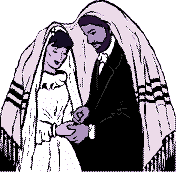
Prewedding Rituals
Jewish tradition contains several prewedding customs to support and honor the bride and groom before their big day. Here are five rituals to help you celebrate, relax, and prepare before the huppah is raised.
SeparationTraditionally, Jewish couples separate for a period of time before the wedding. This split used to last an entire week, but today many couples spend only a couple of days apart. It's an opportunity for the bride and groom to have time alone or be with close family and friends. You may miss each other, but think how happy you'll be when you finally see your honey under the huppah.
Henna parties are held for most Middle Eastern brides -- Muslims, Jews, and Christians alike -- and are often celebrated a few days before the wedding with close women friends and family. The resulting henna designs simultaneously protect and adorn the bride. Often, both mothers feed the bride from trays of Middle Eastern delicacies, including sugar, honey, olives, and almonds -- all things sweet, nothing sour. You're not Sephardic or Mizrahi? Don't worry: Lots of brides from Ashkenazi backgrounds are adopting the custom -- it's a great excuse to be pampered and do a little female bonding.
Aufruf
Jewish to-be-weds are publicly honored with an aufruf, Yiddish for "calling up." On the Sabbath before the wedding (or the Sabbath after the wedding for Sephardi), the groom recites the blessings before and after the first Torah reading. In egalitarian congregations, the bride and groom may say the blessings together. Watch out, though -- when you're done, prepare for the obligatory shower of candies and nuts, wishes for a sweet marriage. The aufruf is usually followed by a celebratory meal.
Mikvah
Before the wedding, Jewish brides immerse in a mikvah, a ritual bath in running water. This joyous occasion is followed by a small party for women friends and family. Sephardic Jews celebrate with a ritual called "noche de bano," or "night of the bath," where the bride is presented with scented soaps and perfumes. Some grooms also go to a mikvah to prepare for their weddings. They may be accompanied by a group of friends and have men-only parties afterwards.
Fasting In most Jewish communities, both bride and groom fast beginning at sundown the night before the wedding. The fast is broken with the first glass of wine under the huppah. Similar to Yom Kippur, marriage fasting is a way to purify oneself, enabling the bride and groom to enter the huppah and their new life together with a clean slate.











